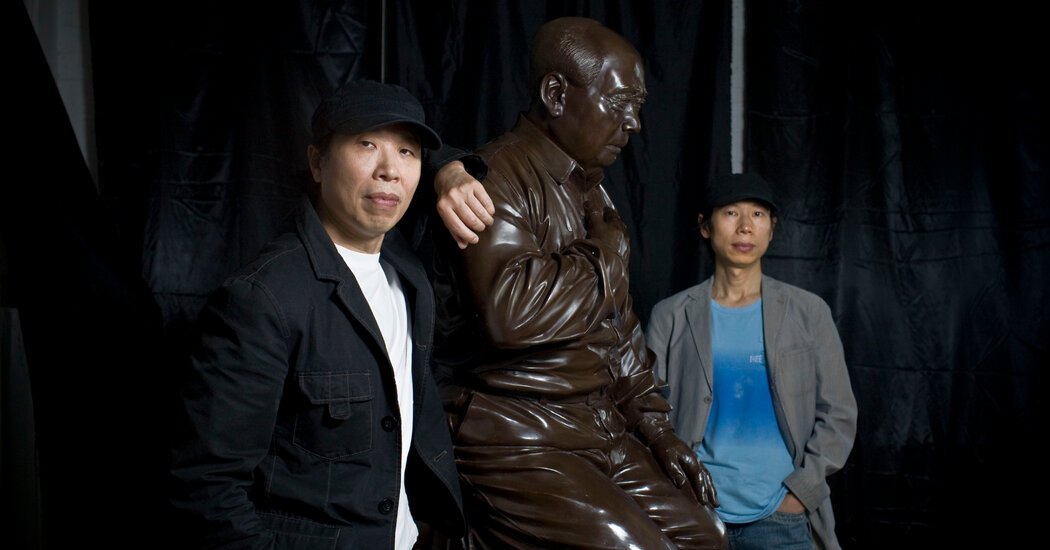
Gao Zhen, a Chinese artist who has drawn international acclaim for works critiquing the Cultural Revolution, has been detained in China, his brother and artistic partner Gao Qiang said on Monday.
The Gao brothers are best known for their statues depicting Mao Zedong in provocative or irreverent ways, such as “Mao’s Guilt,” a bronze statue depicting the leader on his knees, supplicant and remorseful.
The police in Sanhe City detained Gao Zhen, who moved to the United States two years ago, last week while he was visiting China, his younger brother said in an email, on suspicion of slandering China’s heroes and martyrs — a criminal offense punishable by up to three years in prison.
The police also confiscated several of the brothers’ artworks, all of which were created more than 10 years ago and “reassessed Mao’s Cultural Revolution,” Gao Qiang said. The works included “Mao’s Guilt”; “The Execution of Christ,” a statue depicting Jesus facing down a firing squad of Maos; and “Miss Mao,” a collection of statues of Mao with large breasts and a protruding, Pinocchio-like nose.
About 30 police officers stormed the brothers’ art studio on Aug. 26 in Yanjiao, a town in Sanhe City about an hour away from Beijing, Gao Qiang said. The officers asked Gao Zhen, 68, to hand over his mobile phone, and when he refused, they handcuffed and arrested him, Gao Qiang said. Gao Zhen was in China with his wife and son, visiting relatives, his brother said.
The next day, Gao Zhen’s wife was notified by the Sanhe City public security bureau that he was being detained on suspicion of slandering heroes and martyrs, Gao Qiang, 62, said.
The Sanhe public security bureau declined to comment.
The slander of heroes and martyrs was made a crime in 2021, as part of a newly amended criminal code, under a campaign by China’s leader, Xi Jinping, to sanctify the Communist Party’s version of history. “It has been enforced zealously since it came into effect, with officials creating phone and online hotlines for citizens to report violations. A version of the statute was first adopted in 2018 but without criminal punishments.
Gao Qiang said he had been severely depressed and having trouble sleeping since his brother’s detention. He did not know why the police had arrested Gao Zhen now, for artworks created long before the law came into place, he said.
Much of the Gao brothers’ works reflect their personal history. During the Cultural Revolution in the 1960s and 1970s, their father was labeled a class enemy and dragged off to a place that was “not a prison, not a police station, but something else,” where he died, Gao Zhen told The New York Times in 2009.
In 2022, after years of traveling between China and the U.S., where he held permanent residency, Gao Zhen moved to New York, his brother said, both because his son, who is an American citizen, was reaching school age, and because of the “deteriorating environment in China.”
Although the brothers have long clashed with the Chinese authorities over their politically sensitive artwork and have had their exhibitions shut down and their studio raided, they had rarely suffered serious repercussions.
To circumvent the authorities, they had put on invite-only exhibitions, with the location spread only via word of mouth and coded text message hours before the events. They designed the “Mao’s Guilt” statue so that its head could be removed from the body, leaving it unidentifiable.
A decade ago, when Ai Weiwei, China’s most famous dissident artist, was detained, the brothers also “encountered many issues because we accepted interviews with Western media and created artworks involving political figures,” Gao Qiang said. “But we were able to come out the other side unscathed every time.”
But, he said, Gao Zhen’s arrest showed that “now, the space for freedom in China has shrunk a lot compared to then.”






